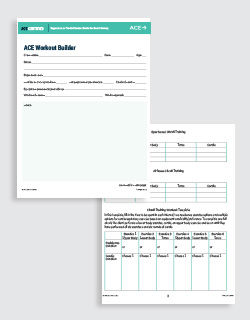
The ACE Workout Builder for Circuit Training

Circuit training can sometimes get lost in the shuffle as people search for the newest trends in program design, but its appeal lies in its simplicity, versatility and proven effectiveness. Circuit training may be a particularly great option for newcomers to muscular training who are performing two or three full-body workouts each week and have not yet progressed to split routines. Many beginners respond really well to circuit training, and it can be a great way to expose new clients to a variety of equipment options.
That said, circuit training is not simply a “workout for beginners,” as it is an effective way to build both muscular and cardiorespiratory fitness and can be the centerpiece of a client’s workout program for the long haul. It’s important to remind clients that progress does not have to come in the form of adding to the number of workouts each week, but instead can be made within the framework of a circuit-training program.
For those who are new to this form of exercise, circuit training involves the use of sequential exercises targeting different muscle groups for a specified amount of time or number of repetitions. This makes it possible for participants to focus on one muscle group while a previously used muscle group is given time to recover. This training method evolved as an adaptation from military training exercises and as a method for maximizing space and time in crowded gymnasiums full of students.
One of the great benefits of circuit training is that it can be used to keep the overall metabolic rate high enough so that cardiorespiratory training effects can occur, while also improving muscular fitness. In other words, circuit training is a time-efficient and effective method of improving both cardiorespiratory fitness and muscular fitness within the same training session. The shorter the rest interval between exercises, or the more quickly clients or participants can transition from one exercise to the next, the greater the metabolic response both during and after the workout.
The Benefits of Circuit Training
Circuit training can yield many health-related benefits. A recent systematic review and meta-analysis showed that circuit training can facilitate significant changes in body composition by decreasing fat mass and increasing muscle mass, and improve both VO2max and cardiorespiratory fitness. This same review of the literature also suggests that circuit training can improve muscular strength.
In older adults, the effects of circuit training have been shown to include improved muscle function, body composition (with high-intensity training), muscular strength, cardiorespiratory endurance, blood pressure (with low-intensity training) and functional autonomy (i.e., the ability to independently perform various tasks required for daily life).
Earlier research demonstrated that circuit training is safe and effective for individuals with clinical disorders, including cardiac disease, diabetes and hypertension, and can improve VO2max and muscular fitness when appropriate loads are used.
Designing the Circuit
The first step in developing a workout program for any client is to understand some key variables, including their goals, needs, experience level, abilities and equipment availability. Weaving all these considerations into a client’s program can be challenging, so we created the ACE Workout Builder to simplify this process for you.
Training Variables
The summary of training variables presented in Table 1 can be used to choose the intensity, sets, repetitions, tempo and rest intervals based on your clients’ goals and level of experience. When considering the most appropriate rest intervals for your clients, it is important to remember that the time spent doing the cardio portion of the workout is part of the rest interval (i.e., active recovery).
As a practical example, consider a circuit that features a 60-second set of a chest exercise, followed by 30 seconds of cardio and then a 60-second set of a lower-body exercise, followed by another 30 seconds of cardio before performing the next upper-body exercise. In this example, the chest will have had a full two minutes of recovery before the upper body is targeted again.
Table 1 shows recommended rest intervals for a targeted muscle group to recover. In circuit training, we want to allow enough time for the muscles targeted with each resistance exercise to recover while minimizing transition times between exercises so that the client keeps their heart rate elevated.
For most clients, the general muscular fitness row of Table 1 will be appropriate, though adjustments should be made based on their training experience (e.g., experienced clients can safely use higher levels of resistance and perform additional rounds of the circuit, if doing so aligns with their goals) or if they have specific goals involving muscular hypertrophy or power, for example.
Table 1. Training Variables
|
Resistance Training Goal/Experience |
Intensity |
Repetitions |
Sets |
Tempo |
Rest |
|
General Muscular Fitness |
20–70% 1-RM |
8–15 |
1–4 |
~6 seconds |
2–3 min |
|
Muscular Endurance |
≤67% 1-RM |
≥12 |
2–3 |
≤30 sec |
|
|
Muscular Hypertrophy |
67–85% 1-RM |
6–12 |
3–6 |
30–90 sec |
|
|
Muscular Strength |
≥85% 1-RM |
≤6 |
2–6 |
2–5 min |
|
|
Power
|
Single effort: 80–90% 1-RM Multiple effort: 75–85% 1-RM |
Single effort: 1-2 Multiple effort: 3–5 |
3–5 |
2–5 min |
|
|
Novice/Intermediate |
60–70% 1-RM (moderate-to-vigorous) |
8–25 |
1–4 |
2–3 min |
|
|
Experienced |
Gradually increase to ≥80% 1-RM (vigorous-to-very-vigorous intensity) to improve strength |
8–25 |
2–4 |
2–3 min |
|
|
Sedentary/Older Adult |
40–50% 1-RM (very-light-to-light intensity) to improve strength |
10–15 |
1–4 |
2–3 min |
Note: 1-RM = One-repetition maximum
The next step is to determine how much weight a client should be lifting, based on the range of one-repetition maximum (1-RM) percentages given in Table 1. You don’t have to ask clients to perform a 1-RM assessment to figure this out. Instead, use this weight training load calculator to identify an appropriate load.
For example, if you have a client who can safely perform 12 repetitions of the chest press exercise with 75 pounds (34 kg), that is roughly 67% of their 1-RM of 112 pounds (51 kg). You can use that value to determine the appropriate load for that exercise if they opt to perform a different number or repetitions during a circuit.
You can also have clients perform each exercise for a set period (as shown in the samples below). In this case, you’ll want to set a time limit for each exercise that will allow the client to achieve a target number of repetitions. This may take some fine tuning, as the tempo for machine, body-weight and free-weight exercises may vary.
So, the two options are to perform a set number of repetitions before moving on to the next exercise in the circuit, or have the client perform each movement for a set amount of time. The latter option is more common, as it allows groups of exercisers to move through a circuit together, as they transition from station to station every minute, for example.
Next, it’s time to choose the exercises you will include in a client’s workouts. To determine this, ask your client where they will be performing each of their workouts and, if outside the gym, what type of equipment they have available. In the ACE Exercise Library, in addition to “Exercises by Body Part” and “Exercises by Experience,” you’ll find a collection of “Exercises by Equipment.” Options include everything from dumbbells and barbells to stability balls and resistance bands. There is even a section for clients who have no equipment at all.
Consider this example: Your client is planning to perform two circuit-training workouts per week, one with you in the gym and one at home. In this case, you can design the gym-based workout using their preferred equipment, perhaps with some back-up options in case a particular machine or piece of equipment isn’t available. For the at-home workout, you can look through the “dumbbell” and “no equipment” sections of the ACE Exercise Library, for example, to choose exercises for this client.
Sample Circuits and Instructions
The following sample circuit-training workouts emphasize both muscular endurance and cardiorespiratory fitness by combining resistance exercises with aerobic exercises that are performed during an active recovery period between the resistance exercises.
Perform each resistance exercise for as many repetitions as can be safely completed in 60 seconds and each cardio exercise for 30 seconds at a moderate intensity (the client should be able to talk but not sing). Be sure to select exercises and order them so that the client can easily transition from one to the next to minimize the rest (≤30 seconds) periods between exercises. For an initial exercise load, use ≤67% 1-RM. Work through this framework from left to right, alternating between resistance exercises and cardio exercises, and complete the full circuit twice.
Gym-based Circuit
This gym circuit contains two options for resistance exercises and multiple types of cardio exercises because you may run into a scenario where a client’s preferred equipment is not available when they need it.
|
|
Lower Body |
Upper Body |
Torso |
Lower Body |
Upper Body |
Torso |
|
(60 seconds) |
or |
or |
or |
or |
or |
or |
|
Cardio (30 seconds) |
Choose 1 Treadmill Elliptical Stationary bike |
Choose 1 Treadmill Elliptical Stationary bike |
Choose 1 Treadmill Elliptical Stationary bike |
Choose 1 Treadmill Elliptical Stationary bike |
Choose 1 Treadmill Elliptical Stationary bike |
Choose 1 Treadmill Elliptical Stationary bike |
At-home Circuit
For the at-home circuit, the client should select exercises that align with their equipment options. For this sample workout, the resistance-training exercises use either the client’s body weight or a light external load, such as a dumbbell.
|
|
Lower Body |
Upper Body |
Torso |
Lower Body |
Upper Body |
Torso |
|
Resistance (60 seconds) |
or |
or |
or |
or |
or |
or |
|
Cardio (30 seconds) |
Choose 1 Jump rope Jumping jacks Marching Run in place
|
Choose 1 Jump rope Jumping jacks Marching Run in place
|
Choose 1 Jump rope Jumping jacks Marching Run in place
|
Choose 1 Jump rope Jumping jacks Marching Run in place
|
Choose 1 Jump rope Jumping jacks Marching Run in place
|
Choose 1 Jump rope Jumping jacks Marching Run in place
|
Final Thoughts
Circuit training is an effective and time-efficient form of training that combines total-body resistance training and cardiorespiratory exercise into a single session. And, importantly, it’s appropriate for exercisers at any level of fitness and experience, as a circuit can feature stability and mobility exercises for beginners and be progressed in multiple ways—by adding more exercises or circuits to each workout, by adding more workouts per week or by increasing the difficulty or level of resistance for each individual exercise. Whether you are working with individuals, small groups or even large group fitness classes, circuit training is a safe, effective and appropriate programming option that can add variety and fun to your clients’ workouts.

More Articles
- Certified™: August 2024
Postpartum Fitness: Working With Clients After a Cesarean Birth
Contributor
- Certified™: August 2024
Exercise Programming for Clients Who Have Type 2 Diabetes
- Certified™: August 2024
How Running Like an Animal Makes Us Human
Health and Fitness Expert




 by
by 


